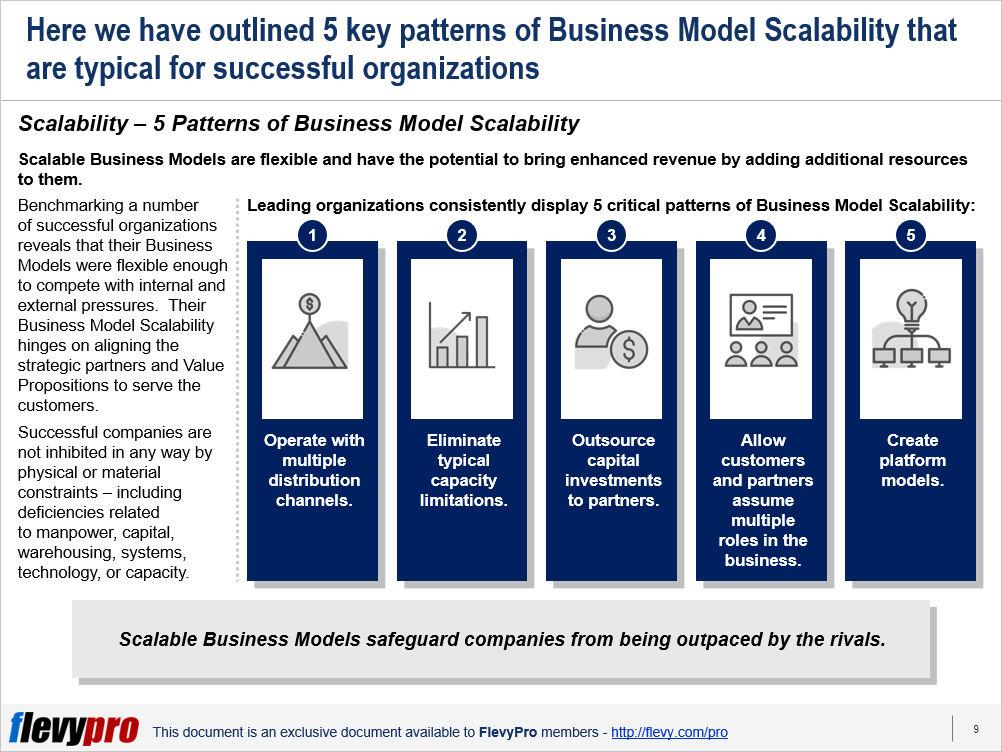Scalability is defined as possible meaningful changes in magnitude or capacity. In business terms, it’s the capability of a system to enhance productivity upon resource augmentation. Scalability provides an organization the capabilities to develop compelling value propositions—that are hard to imitate by the rivals—and achieve profitable growth even in the wake of external threats, cut-throat competition, stringent laws, or financial downturns.
Today’s challenging business ecosystems and economic outlook demand from the enterprises to develop novel and Scalable Business Models that are able to leverage positive returns on investments. To accomplish this, leaders need to identify and eradicate any capacity issues, enhance collaboration with existing partners, build new partnerships, or develop platforms to work with their opponents.
Executives should invest in scaling options only when they are sure to boost returns. They have to be quick to exit a business when returns on investment to scale backfire.
5 Patterns of Business Model Scalability
Benchmarking a number of successful organizations reveals that their Business Models were flexible enough to sustain internal and external pressures. Business Model Scalability hinges on aligning the strategic partners and Value Propositions to serve the customers.
To drive Business Model Innovation (BMI), leading organizations consistently display 5 critical patterns of Business Model Scalability:
- Operate with multiple distribution channels
- Eliminate typical capacity limitations
- Outsource capital investments to partners
- Allow customers and partners assume multiple roles in the business
- Create platform models
Operate with multiple distribution channels
Successful businesses achieve scalability by selling through multiple distribution channels. Well-known businesses—e.g., Google and Apple—have extensively studied and implemented adding additional distribution channels. By avoiding cannibalization of sales through existing channels, this has allowed them to spread overhead costs and profit from increased sales. Additional channels help businesses expand clientele and uncover new opportunities.
Eliminate typical capacity limitations
Scalability necessitates finding ways to overcome capacity limitations that hamper various industries. Well-known companies achieve scalability by overpowering any limitations that constrain various businesses. Successful companies are not inhibited in any way by physical or material constraints—including deficiencies related to manpower, capital, warehousing, systems, technology, or capacity. For example, managing costs related to creating R&D facilities and innovating new products that often impede the entire pharmaceutical industry.
Outsource capital investments to partners
Top businesses achieve scalability by transferring or sharing cash flow and working capital requirements with the partners. They optimize their capital and cash flow limitations and prioritize their crucial investments. They adopt Business Models geared toward creating open platforms that allow them to shift these expenditures to their strategic partners.
Allow customers and partners assume multiple roles in the business
Scalable businesses work in conjunction with their strategic partners and customers. They offer multiple roles to them and leverage mutual resources for growth of their businesses. They collaborate with each other through joint ventures or through informal mechanisms—e.g., core platforms—which they utilize to share distribution methods, loyalty programs, and resources. They have a “laser” focus on the factors that are of value to their customers, and develop (and enrich) their value propositions based on that.
Create platform models
Top businesses build platform-based Business Models that work on the principles of partnership and scalability. They use their platform-based Business Models to foster relationships with and convert their rivals into partners—by letting them share their platform and generate incremental revenues, for instance, through benchmarking data and “ease of use” sales. Visa Inc. is an example of how businesses connect with shoppers using Visa’s credit card platform.
Scalable Business Models are more likely to generate rapid returns. However, these Business Models demand utilization and alignment of capabilities that the organization, its strategic partners, and customers possess. Execution of the patterns of Business Model Scalability involves categorizing key resources and initiatives required to enable synergistic collaboration and superior product / service offerings.
Executives can make use of these 3 potential levers to achieve Business Model Scalability that provide an implementation roadmap for both novel or revamped Business Models:
- Determine potential strategic partners
- Brainstorm a scalability plan
- Select viable and scalable Business Model options
Interested in learning more on the 3 potential levers to scalability? You can download an editable PowerPoint on Business Model Innovation: Scalable Business Models here on the Flevy documents marketplace.
Are you a Management Consultant?
You can download this and hundreds of other consulting frameworks and consulting training guides from the FlevyPro library.

Comments